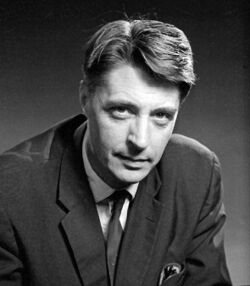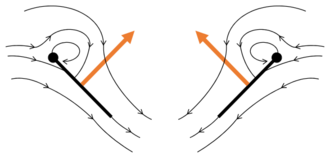Biography:Torkel Weis-Fogh
Torkel Weis-Fogh | |
|---|---|
 | |
| Born | March 25, 1922 Aarhus, Denmark |
| Died | 13 November 1975 (aged 53)[1] Cambridge, England |
| Nationality | Danish |
| Alma mater | University of Copenhagen |
| Known for | |
| Scientific career | |
| Fields | |
| Institutions | |
| Doctoral advisor | August Krogh |
Torkel Weis-Fogh (25 March 1922 – 13 November 1975) was a Denmark zoologist and Professor at the University of Cambridge and the University of Copenhagen.[1][7][8][9][10][11] He is best known for his contributions to the understanding of insect flight, especially the clap and fling mechanism used by very small insects. James Lighthill named this the Weis-Fogh mechanism of lift generation.[12][13]
Education
Weis-Fogh was born in Aarhus and educated at University of Copenhagen.
Research and career
Weis-Fogh was research assistant to the Danish Nobel Prize–winning physiologist August Krogh, where he studied the flight mechanism of the desert locust.[14][15][16]
He pioneered studies of insect flight with Krogh in a classic paper of 1951.[17] He then spent a year at the Copenhagen Institute of Neurophysiology.[12]
Weis-Fogh then went to the University of Cambridge in England for four years, where he discovered a rubbery protein, resilin, in insect cuticle.[12][18] He continued working on insect flight.[19][20][21][22][23]
He returned to Copenhagen as Professor of Zoophysiology, but went back to Cambridge in 1966 to become Professor of Zoology there, continuing to investigate mechanisms of cell motility and of flight.[12][24][25][26][27][28]
Insect flight

In 1973 Weis-Fogh devised a mathematical model explaining how extremely small insects such as the thrips or chalcid wasps like Encarsia formosa could fly using clap-and-fling,[29] where conventional steady state aerodynamics did not apply. These insects gain lift by creating vortices near their wings, at the price of the wear and tear from repeated clapping. The British mathematician Sir James Lighthill named this the Weis-Fogh mechanism of lift generation.[12][13] Weis-Fogh's 1973 paper Quick Estimates of Flight Fitness in Hovering Animals, Including Novel Mechanisms for Lift Production[30] has been cited over 1000 times.[31]
Awards and honours
The Hanne and Torkel Weis-Fogh fund is named in his honour.[32]
References
- ↑ 1.0 1.1 Treherne, J. E. (1976). "Obituary Torkel Weis-Fogh 1922–1975". Tissue and Cell 8 (1): i. doi:10.1016/0040-8166(76)90015-X. PMID 772881.
- ↑ Sane, S. P. (2011). "Steady or Unsteady? Uncovering the Aerodynamic Mechanisms of Insect Flight". Journal of Experimental Biology 214 (3): 349–351. doi:10.1242/jeb.048330. PMID 21228193.
- ↑ Weis-Fogh, T. (1975). "Unusual Mechanisms for the Generation of Lift in Flying Animals". Scientific American 233 (5): 80–87. doi:10.1038/scientificamerican1175-80. PMID 1188343.
- ↑ Weis-Fogh, T. (1964). "Biology and Physics of Locust Flight. 8. Lift and Metabolic Rate of Flying Locusts". The Journal of Experimental Biology 41: 257–71. PMID 14187298.
- ↑ Weis-Fogh, T. (1956). "The Flight of Locusts". Scientific American 194 (3): 116–126. doi:10.1038/scientificamerican0356-116.
- ↑ Furber, S. B.; Williams, J. E. F. (1979). "Is the Weis-Fogh principle exploitable in turbomachinery?". Journal of Fluid Mechanics 94 (3): 519. doi:10.1017/S0022112079001166.
- ↑ "Torkel Weis-Fogh: Scientific Papers and Correspondence". http://www.archiveshub.ac.uk/news/0603fogh.html.
- ↑ Weis-Fogh, T.; Jensen, M. (1956). "Biology and Physics of Locust Flight. I. Basic Principles in Insect Flight. A Critical Review". Philosophical Transactions of the Royal Society B: Biological Sciences 239 (667): 415–458. doi:10.1098/rstb.1956.0007.
- ↑ Jensen, M.; Weis-Fogh, T. (1962). "Biology and Physics of Locust Flight. V. Strength and Elasticity of Locust Cuticle". Philosophical Transactions of the Royal Society B: Biological Sciences 245 (721): 137–169. doi:10.1098/rstb.1962.0008.
- ↑ Torkel Weis-Fogh's publications indexed by the Scopus bibliographic database. (Subscription content?)
- ↑ Weis-Fogh, T. (1956). "Biology and Physics of Locust Flight. II. Flight Performance of the Desert Locust (Schistocerca gregaria)". Philosophical Transactions of the Royal Society B: Biological Sciences 239 (667): 459–510. doi:10.1098/rstb.1956.0008.
- ↑ 12.0 12.1 12.2 12.3 12.4 "Torkel Weis-Fogh: Scientific Papers and Correspondence". University of Cambridge. http://janus.lib.cam.ac.uk/db/node.xsp?id=EAD%2FGBR%2F0012%2FMS%20Add.8250.
- ↑ 13.0 13.1 Lighthill, M. J. (1973). "On the Weis-Fogh mechanism of lift generation". Journal of Fluid Mechanics 60: 1–17. doi:10.1017/s0022112073000017.
- ↑ Weis-Fogh, T. (1952). "Fat Combustion and Metabolic Rate of Flying Locusts (Schistocerca gregaria Forskal". Philosophical Transactions of the Royal Society B: Biological Sciences (London: Royal Society) 237 (640): 1–36. doi:10.1098/rstb.1952.0011.
- ↑ Weis-Fogh, T. (1956). "Biology and Physics of Locust Flight. IV. Notes on Sensory Mechanisms in Locust Flight". Philosophical Transactions of the Royal Society B: Biological Sciences 239 (667): 553–584. doi:10.1098/rstb.1956.0010.
- ↑ Weis-Fogh, T. (1949). "An Aerodynamic Sense Organ Stimulating and Regulating Flight in Locusts". Nature 164 (4177): 873–874. doi:10.1038/164873a0. PMID 15393878.
- ↑ Krogh, August; Weis-Fogh, Torkel (1951). "The Respiratory Exchange of the Desert Locust (Schistocerca Gregaria) before, During and After Flight". Journal of Experimental Biology (The Company of Biologists) 28 (3): 344–357. http://jeb.biologists.org/content/28/3/344.
- ↑ Andersen, S. O.; Weis-Fogh, T. (1964). "Resilin. A Rubberlike Protein in Arthropod Cuticle". Advances in Insect Physiology Volume 2. Advances in Insect Physiology. 2. pp. 1. doi:10.1016/S0065-2806(08)60071-5. ISBN 9780120242023.
- ↑ Weis-Fogh, T. (1964). "Biology and Physics of Locust Flight. 8. Lift and Metabolic Rate of Flying Locusts". The Journal of Experimental Biology 41: 257–71. PMID 14187298.
- ↑ Weis-Fogh, T. (1964). "Control of basic movements in flying insects". Symposia of the Society for Experimental Biology 18: 343–63. PMID 5838601.
- ↑ Weis-Fogh, T. (1964). "Diffusion in Insect Wing Muscle, the Most Active Tissue Known". The Journal of Experimental Biology 41: 229–56. PMID 14187297.
- ↑ Buchthal, F; Weis-Fogh, T.; Rosen-Falck, P (1957). "Twitch contractions of isolated flight muscle of locusts". Acta Physiologica Scandinavica 39 (2–3): 246–76. doi:10.1111/j.1748-1716.1957.tb01427.x. PMID 13444040.
- ↑ Buchthal, F; Weis-Fogh, T. (1956). "Contribution of the sarcolemma to the force exerted by resting muscle of insects". Acta Physiologica Scandinavica 35 (3–4): 345–64. doi:10.1111/j.1748-1716.1955.tb01291.x. PMID 13313192.
- ↑ Weis-Fogh, T.; Andersen, S. O. (1970). "New Molecular Model for the Long-range Elasticity of Elastin". Nature 227 (5259): 718–21. doi:10.1038/227718a0. PMID 5432073.
- ↑ Routledge, L. M.; Amos, W. B.; Gupta, B. L.; Hall, T. A.; Weis-Fogh, T (1975). "Microprobe measurements of calcium binding in the contractile spasmoneme of a vorticellid". Journal of Cell Science 19 (1): 195–201. PMID 809455.
- ↑ Weis-Fogh, T. (1975). "Unusual mechanisms for the generation of lift in flying animals". Scientific American 233 (5): 81–7. doi:10.1038/scientificamerican1175-80. PMID 1188343.
- ↑ Weis-Fogh, T.; Amos, W. B. (1972). "Evidence for a New Mechanism of Cell Motility". Nature 236 (5345): 301–4. doi:10.1038/236301a0. PMID 4622429.
- ↑ Moreton, R. B.; Echlin, P.; Gupta, B. L.; Hall, T. A.; Weis-Fogh, T. (1974). "Preparation of Frozen Hydrated Tissue Sections for X-ray Microanalysis in the Scannning Electron Microscope". Nature 247 (5436): 113–5. doi:10.1038/247113a0. PMID 4587972.
- ↑ Santhanakrishnan, A.; Robinson, A. K.; Jones, S.; Low, A. A.; Gadi, S.; Hedrick, T. L.; Miller, L. A. (2014). "Clap and fling mechanism with interacting porous wings in tiny insect flight". Journal of Experimental Biology 217 (21): 3898–3909. doi:10.1242/jeb.084897. ISSN 0022-0949. PMID 25189374.
- ↑ Weis-Fogh, T. (1973). "Quick estimates of flight fitness in hovering animals, including novel mechanisms for lift production". Journal of Experimental Biology 59: 169–230. http://jeb.biologists.org/content/59/1/169.abstract.
- ↑ "Quick estimates of flight fitness in hovering animals, including novel mechanisms for lift production". Google Scholar. https://scholar.google.com/scholar?hl=en&as_sdt=0%2C5&q=Quick+Estimates+of+Flight+Fitness+in+Hovering+Animals%2C+Including+Novel+Mechanisms+for+Lift+Production%23&btnG=.
- ↑ "Hanne and Torkel Weis-Fogh Fund". University of Cambridge Department of Zoology. http://www.zoo.cam.ac.uk/research/res-support/funding/trust-funds/weis-fogh.

